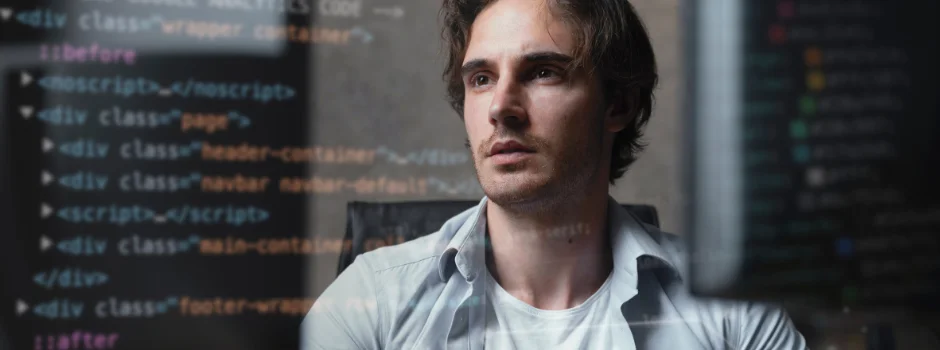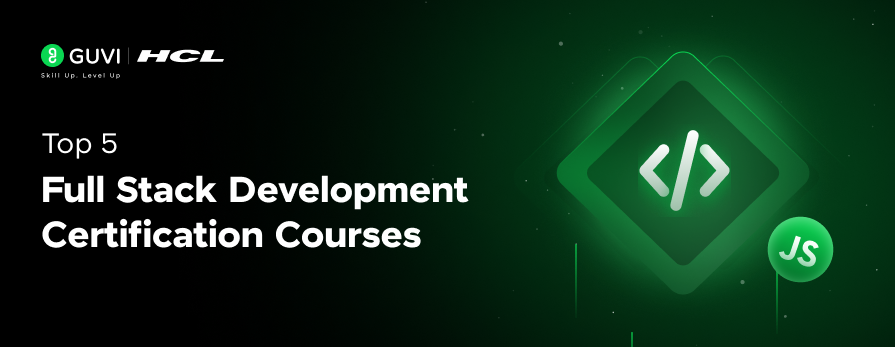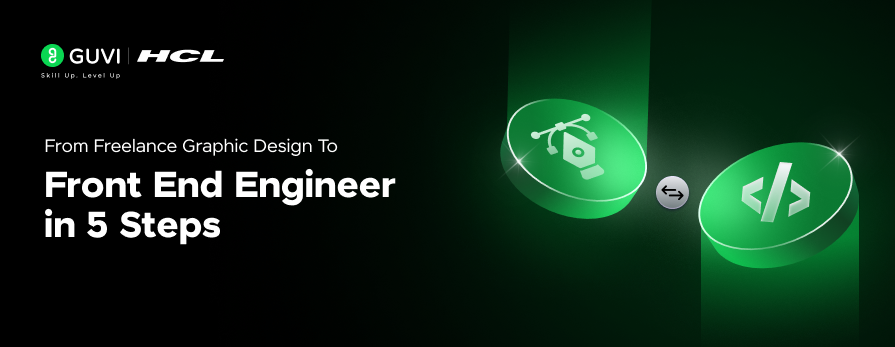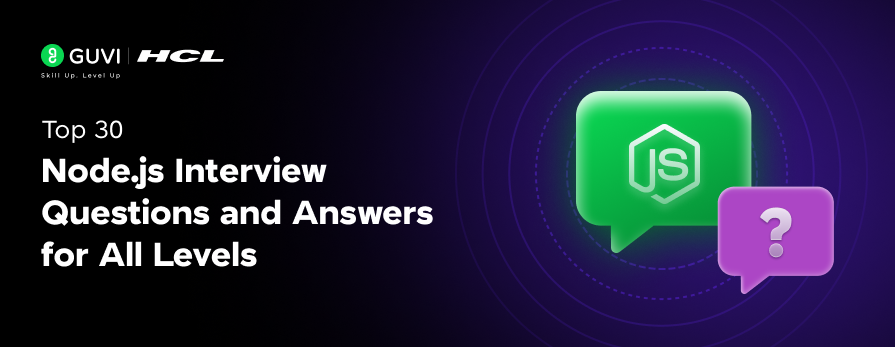
Top Skills To Become a Full-Stack Developer in 2025
Mar 24, 2025 6 Min Read 7968 Views
(Last Updated)
Are you interested in becoming a great full-stack developer? If so, then you’re at the right place! In this comprehensive guide, we will explore the skills and knowledge required to excel in this multifaceted role.
Everybody in the tech industry knows what full stack development is and how crucial of a skill it is to have, not to mention the attractive salary packages that await and what a great career path it is!
Whether you’re a beginner or an experienced developer looking to upskill, this article will provide valuable insights to become a successful full-stack developer as we will be listing out and discussing all of the essential skills required for full-stack developers. So let’s dive in!
Table of contents
- What is a Full Stack Developer?
- Front-End Development
- Back-End Development
- Database Management
- Skills Required to Become a Great Full Stack Developer
- Proficiency in HTML and CSS
- Mastery of JavaScript
- Version Control with Git and GitHub
- Back-End Development Languages
- Understanding of Web Architecture
- Database Management Systems
- Fundamental Design Skills
- Knowledge of REST and SOAP
- Familiarity with Technology Stacks
- Soft Skills
- Frequently Asked Questions
- Can I become a full-stack developer without any experience?
- What do I need to know to become a full-stack developer?
- Which full stack is best?
- Is full-stack development a good career choice?
- How long does it take to become a full-stack developer?
- Conclusion
What is a Full Stack Developer?
A full-stack developer is a tech professional who possesses expertise in both front-end and back-end technologies, as well as database management.

In simple terms, full-stack developers are responsible for developing and maintaining all aspects of a web application, from the user interface to the server-side logic as well as database management.
This multidimensional role requires a diverse skill set and the ability to work on various elements of web development. Let us explore them:
1. Front-End Development
Front-end development, also known as client-side development, focuses on creating the user-facing components of a website or application.
It involves using languages such as HTML, CSS, and JavaScript to design and implement the visual elements and user interactions. Front-end developers are responsible for ensuring an appealing and intuitive user experience.
2. Back-End Development
Back-end development, also known as server-side development, deals with what we would call the “behind-the-scenes” functionality of a web application.
It involves working with server-side languages like Python, Java, PHP, or Ruby to handle the logic and data manipulation. Back-end developers ensure the smooth functioning of the application and manage the databases that store and retrieve data.
3. Database Management
Database management is a very important aspect of full-stack development. Full-stack developers should deeply understand database systems such as MySQL, Oracle, or SQLite. They should be proficient in handling database operations, ensuring data integrity, and optimizing database performance.
Skills Required to Become a Great Full Stack Developer
To become a great full stack developer, you need to acquire a diverse range of skills. Let’s explore the top 10 skills that will help you excel in this role:
1. Proficiency in HTML and CSS
HTML (Hypertext Markup Language) and CSS (Cascading Style Sheets) are fundamental skills for front-end development. HTML is used to structure the content of a web page, while CSS is used to style and format the HTML elements. A great full-stack developer should have a strong grasp of these languages to create visually appealing and interactive user interfaces.
HTML, also known as Hypertext Markup Language, is a language that plays a crucial role in front-end technologies. Developers utilize HTML to control the formatting and visual aspects of text and images on websites. It serves as the foundation for organizing webpage structures, including headings, paragraphs, body content, pop-ups, and so much more.
On the other hand, CSS stands for Cascading Style Sheets and serves as an essential style language used to customize HTML elements. With CSS’s powerful personalization capabilities at your disposal, you can easily apply different colors or styles to your headings and paragraphs.
For any full-stack developer aiming to excel in client-side application development work with enhanced user interaction and visuals on web applications requires proficiency in both these fundamental frontend tools – HTML & CSS.
By harnessing the power of these languages effectively together, developers can create captivating web experiences that leave a lasting impact on users.
2. Mastery of JavaScript
JavaScript is a dynamic programming language that enables interactive and responsive front-end development. It allows developers to add functionality and interactivity to web applications.
However, due to its versatility, it can also be utilized for server-side development. JavaScript’s seamless integration with HTML, CSS, and compatibility with major browsers greatly simplifies and enhances the work of developers.
Moreover, there are numerous frameworks available for front-end development such as Angular, React, React Native, Vue, and many more. To thrive in this field as a full-stack developer, it is imperative to possess a solid foundation in JavaScript.
Additionally, staying abreast of new libraries or frameworks introduced in this language is crucial for continuous growth. To truly excel, a full-stack developer should have an in-depth understanding of all the capabilities that JavaScript has to offer.
3. Version Control with Git and GitHub
In the realm of web development, one cannot simply overlook the significance of Git and GitHub. These two tools are like a dynamic duo that empowers both novice and seasoned developers alike. Git, often referred to as a “distributed version control system,” plays an instrumental role in managing every intricate step of the development process.
What sets it apart from other control systems is its unparalleled efficiency in resolving errors and tracking progress. With Git, you have full control – monitor your advancements, make alterations, capture snapshots of your work, revert back if needed, and so much more.
On the other hand, GitHub serves as a comprehensive platform where developers can collaborate on multiple projects simultaneously while effortlessly handling project management and code review tasks. As its name implies, it creates an invaluable hub for networking with fellow developers from all corners of the globe.
Utilizing Git’s remarkable features to their fullest extent, GitHub provides an ideal workspace for developers seeking seamless collaboration. For aspiring full-stack developers looking to enhance their skill set, GitandGitHub offer immense value by cultivating essential team management skills along with leadership abilities and fostering a spirit of cooperation within them.
In addition to streamlining coding processes, Git and GitHub significantly boost efficiency levels, making complex tasks feel effortless and delivering optimal results
4. Back-End Development Languages
To excel as a full-stack developer, you should be proficient in at least one back-end programming language. Popular choices include Python, Java, PHP, and Ruby. Each language has its own frameworks and libraries that simplify back-end development tasks.
Python is widely recognized as one of the top programming languages for backend development, thanks to its powerful frameworks such as Django and Flask. Its user-friendly syntax and rich features make it suitable for a wide range of high-level object-oriented and structured programming tasks.
Java, on the other hand, stands out as an innovative “class-based” language that goes beyond web application development. It’s also a preferred choice for creating mobile applications and desktop applications, making it a versatile language that caters to developers’ needs across different platforms.
When it comes to PHP, this dynamic programming language offers compatibility along with impressive speed, resilience, and efficiency. With its server-side scripting capabilities and adaptability to operating systems like macOS, Unix, and Windows; PHP remains one of the most popular choices for backend development.
Ruby is another language that shines in both backend development and web application creation. Notable for its simplicity in code structure, dynamic typing features, and adherence to object-oriented principles; Ruby stands apart from other languages by offering multiple approaches for problem-solving during coding sessions. Additionally, Ruby has introduced an open-source framework known as Ruby on Rails which aids developers in enhancing their productivity through efficient workflow management.
5. Understanding of Web Architecture
To thrive in their role, a full-stack developer must constantly enhance their skills and expertise. This includes having a fundamental understanding of web architecture.
As the go-to person for various components, the team relies on the full-stack developer to possess knowledge about essential elements such as DNS (Domain Name System), database servers, cloud storage, and much more.
From structural foundations to user interface elements of web applications, they are expected to be well-versed in these areas and beyond. Upskilling is key for these developers to excel in their responsibilities and deliver exceptional results.
6. Database Management Systems
As a full-stack developer, you will work extensively with databases. Familiarity with database management systems like MySQL, Oracle, or SQLite is crucial.
You as a full-stack developer should be proficient in designing and managing databases, ensuring data integrity, as well as optimizing database performance.
7. Fundamental Design Skills
Many experts argue that a development team and a design team have distinct roles. However, as a versatile full-stack developer, it is crucial to possess fundamental design knowledge in order to enhance the visual appeal and interactivity of front-end development.
Having this skill will enable you to grasp user psychology during the creation of the client side of an application. By understanding how users think and behave, you can develop an interface that effectively engages them and meets their needs.
8. Knowledge of REST and SOAP
In the role of a full-stack developer, one must serve as a vital link connecting the crucial components of web application development. Effective communication between these elements is absolutely essential.
To excel in this capacity, a full-stack developer should possess expertise in working with web services or application program interfaces (APIs) such as REST and SOAP.
By leveraging these two web services, you can seamlessly exchange data between disparate systems, resulting in enhanced efficiency and productivity. This integration plays a pivotal role in streamlining operations and achieving optimal results.
9. Familiarity with Technology Stacks
To become a skilled full-stack developer, it is essential to have a deep understanding of various technologies and continuously update oneself in accordance with the demands of the role.
Each company has its own preferences when it comes to technology stacks for developing web applications, so it’s crucial to stay informed about the popular ones. Among these stacks are LAMP stack and Django stack, which you should be familiar with.
Take the time to learn about how they work and understand all the different layers involved in building an application. By staying knowledgeable and adaptable, you’ll be well-equipped to create outstanding web applications that meet industry standards.
10. Soft Skills
When it comes to web development roles, certain soft skills play a vital role in complementing the responsibilities of the job. Even though these skills are often linked to an individual’s character traits, they can still be developed through practice.

Communication and problem-solving are two crucial soft skills for a full stack web developer.
Problem-solving abilities: As web developers tackle challenges and navigate complex projects, their problem-solving abilities become invaluable.
Creativity: A touch of creativity allows developers to design visually captivating websites that not only look great but also function optimally.
Patience: Web development involves time-consuming coding and testing processes. Patience is essential as developers meticulously work through each step to ensure everything is perfect.
Attention to detail: Developers with exceptional attention to detail consistently deliver high-quality work that meets all requirements down to the smallest elements.
Communication skills: Good communication fosters collaboration within teams, creating a positive and productive work environment where ideas flow freely.
By embracing these soft skills alongside technical expertise, web developers can excel in their roles while delivering outstanding results.
Frequently Asked Questions
Yes, you can most definitely become a full-stack developer without any prior experience, it’s all about the skills you possess. However, acquiring a range of skills such as HTML, CSS, JavaScript, Python, database management fundamentals, and more will increase your chances of standing out in the competitive job market.
In order to become a full-stack developer, you need to have a well-established understanding of both front-end as well as back-end development, and database management. Familiarity with languages like HTML, CSS, JavaScript, Python, and databases like MySQL or Oracle is essential.
The choice of the best full stack depends on the specific requirements of the project or company. However, the MERN stack (MongoDB, Express.js, React.js, Node.js) is gaining popularity due to its versatility and efficiency in building scalable web applications.
Yes, full-stack development is a promising career choice. The demand for full-stack developers is on the rise as companies seek professionals who can handle both front-end and back-end development. This multidimensional role offers ample opportunities for learning, growth, and career advancement.
The time required to become a full-stack developer differs per individual based on factors such as prior experience, learning capacity, and dedication. On average, it can take around 3-6 months to acquire a basic understanding of full-stack development. However, continuous learning and upskilling are essential for staying updated in this rapidly evolving field.
Before diving into the next section, ensure you’re solid on full-stack development essentials like front-end frameworks, back-end technologies, and database management. If you are looking for a detailed Full Stack Development career program, you can join GUVI’s Full Stack Development Career Program with placement assistance. You will be able to master the MERN stack (MongoDB, Express.js, React, Node.js) and build real-life projects.
Additionally, if you want to explore JavaScript through a self-paced course, try GUVI’s JavaScript self-paced certification course.
Conclusion
To further enhance your skills and knowledge as a full-stack developer, here are some valuable resources that will not only teach you about full stack development from the ground up but also help you bag your dream development job:
- The Full Stack Development Bootcamp by GUVI will have you learning from top industry experts and coding in no time AND you also get Placement Assistance. A great option for newbies and pros alike according to me, do check it out!
- The individual language courses by GUVI are also a great option for people looking to start slow, we have all kinds of popular languages being taught by top industry leaders. Some of them are Python, JavaScript, HTML, CSS and so much more.
Remember, becoming a great full stack developer is a journey that requires continuous learning and practice. By acquiring the right skills, staying updated with industry trends, and developing your soft skills, you can pave the way for a successful and fulfilling career in full-stack development. Good luck on your journey!






















![Top 40 Java Full Stack Developer Interview Questions and Answers [2025] 4 java full stack developer interview questions](https://www.guvi.in/blog/wp-content/uploads/2025/06/Top-40-Java-Full-Stack-Developer-Interview-Questions-and-Answers.png)




![Top Frontend Developer Skills: A Beginner's Guide [2025] 9 frontend developer skills](https://www.guvi.in/blog/wp-content/uploads/2023/03/Top-Frontend-Developer-Skills-A-Beginners-Guide.png)

![Top 10 React Native Project Ideas [With Source Code] 11 React Native Project Ideas](https://www.guvi.in/blog/wp-content/uploads/2024/10/React_Project_Ideas.png)


Did you enjoy this article?